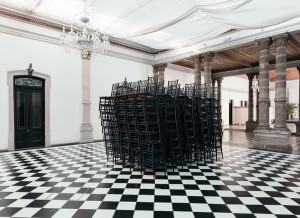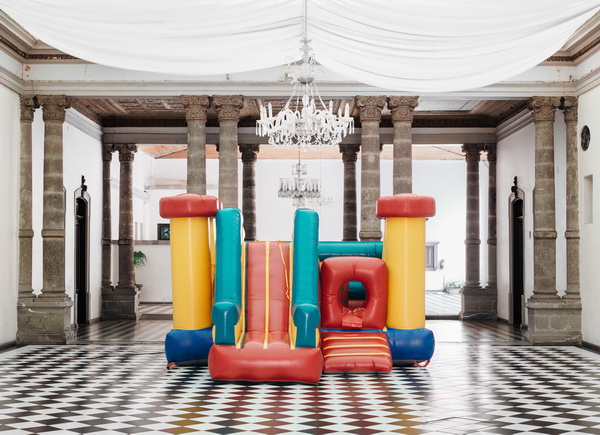Carmen Argote is a Los Angeles-based multimedia artist who works directly in response to particular locations. Last year, she created a site- specific installation at the MAK Center where she traced the interior and exterior footprint of the Schindler house using untreated lumber (basic two-by-fours). She later relocated the installation to High Desert Test Sites, transposing one location and vista onto another. Her works are reflections on memory, personal histories, her own immigrant experience and the process of adapting to new locations. Though best known for her installations, this is the first exhibition devoted to her photography.
Mansión Magnolia is a public space located in Guadalajara, Mexico that was Argote’s ancestral home and serves as the exhibition’s title. The images she has taken there document the architecture, props and detritus left behind by the visiting public and workers, as well as private performances she created for the camera. These large-scale color photographs focus on the incongruities between the beauty of the magnificent 1890s Neo-Classical mansion juxtaposed with the banality of contemporary objects brought into the space for event rentals. This is most evident in Brincolin (all works 2016), a photograph of a colorful, inflatable children’s bounce house in the shape of a castle.

Carmen Argote, Black Chairs, 2016. ©Carmen Argote, courtesy of Shulamit Nazarian, Los Angeles.
The primary colors of the children’s plaything are presented in direct contrast to the somber tones of the original architecture, yet there is an ironic similarity between the shapes of the plastic shafts and the stone columns in the background. Similarly, Black Chairs pictures hundreds of chairs stacked atop a black-and-white checkerboard tiled floor in the center of an otherwise empty ballroom, collectively asserting their presence as sculpture. The building’s regal architecture subsumes anything that tries to leave a mark, be it the aftermath of a party, crumpled Styrofoam cups, the empty refrigerator units in what used to be the servant’s quarters, or even the ghost-like form of Argote’s moving body captured in the frame.
While most of the images are devoid of people, as Argote documents the mansion and its architectural novelties (both past and present), two evocative photographs include the trace of her body. In a long exposure, Argote recorded her movements in the space capturing her soft naked form in contrast to the harsh gridded and patterned geometry of the floor. These pieces, titled Las Lindas and Tias, speak most directly to her conflicting feelings of being a foreigner in the space that was once her family home.
The photographs in Mansión Magnolia become an intimate portrait of a place that refuses to become an empty shell devoid of the vibrancy and life it once supported. Argote is acutely aware of this history and the building’s transformation from a private to a public space and through careful framing, as well as private ritual, has claimed the space as her own.


